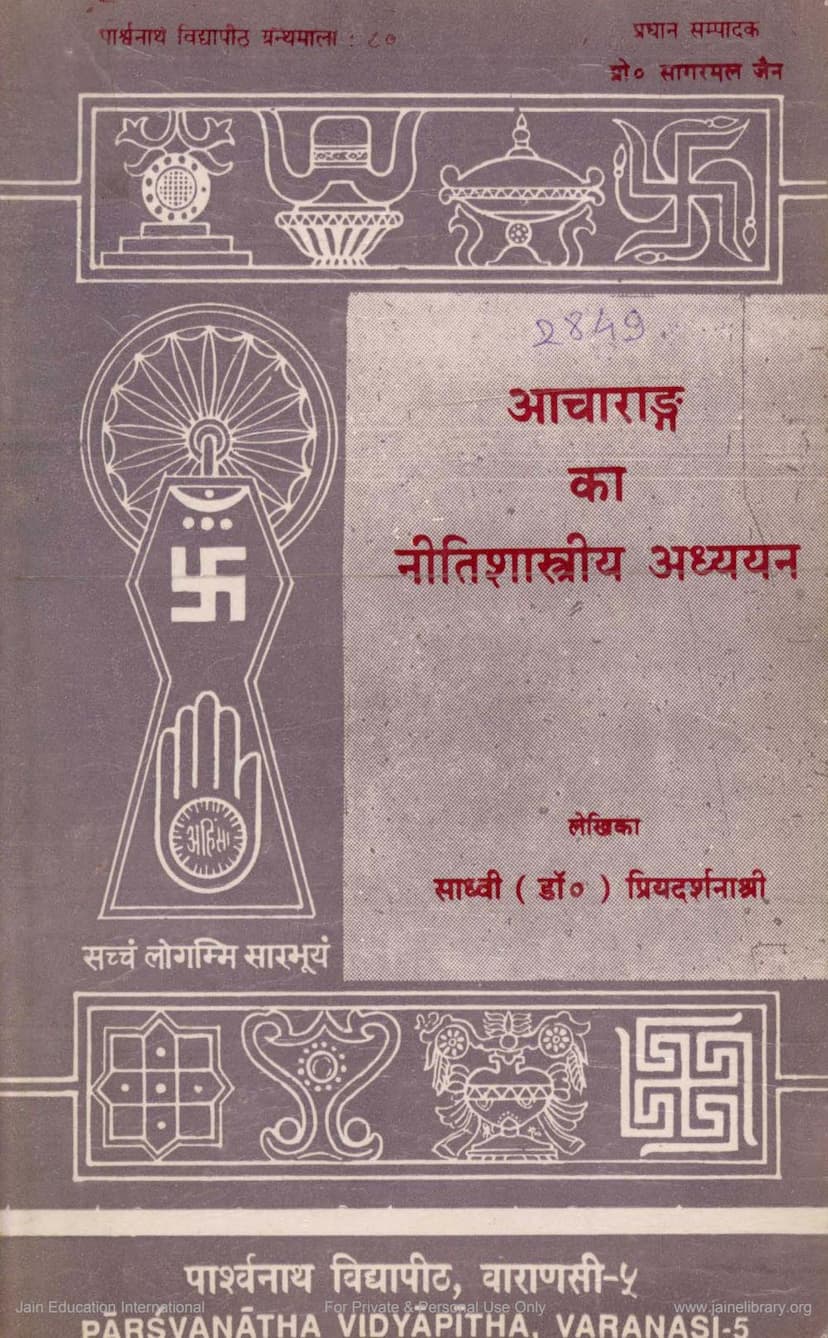Acharanga Ka Nitishastriya Adhyayana
Added to library: September 1, 2025

Summary
Here is a comprehensive summary in English of the Jain text "Ācārāṅga kā Nitiśāstrīya Adhyayana" by Sadhvi (Dr.) Priyadarshanashri:
This book, "Ācārāṅga kā Nitiśāstrīya Adhyayana" (A Ethical Study of Ācārāṅga Sūtra), authored by Sadhvi (Dr.) Priyadarshana Shri and published by Parshwanath Shodhpith Varanasi, presents a detailed ethical analysis of the Ācārāṅga Sūtra, a foundational text in Jain Agam literature. The author's work is commendable for being one of the first to critically examine the Ācārāṅga Sūtra from the perspective of Western ethical philosophy. While Dr. Sagarmal Jain had previously conducted a broader study of Jain ethics in relation to Eastern and Western philosophies, Sadhvi Priyadarshana Shri's focus on the Ācārāṅga Sūtra specifically, and its comparison with Western ethical principles, marks this book as a unique and authoritative contribution to the field.
The book is structured into eight chapters, systematically exploring the ethical dimensions of the Ācārāṅga Sūtra:
-
Chapter 1: The Nature and Subject Matter of Ācārāṅga: This chapter establishes the position and significance of the Ācārāṅga Sūtra within Jain Agam literature. It delves into its language, style, authorship, and comprehensively outlines its subject matter, covering the ten Śrutaskandhas and their respective studies.
-
Chapter 2: Metaphysical Foundations of Ethics in Ācārāṅga: This chapter investigates the underlying metaphysical principles that form the basis of ethics in the Ācārāṅga Sūtra. It discusses the nature of the soul, its agency and experience, the concept of the liberated soul, the immortality of the soul, the doctrine of rebirth, self-autonomy, and the role of karma in bondage and suffering.
-
Chapter 3: Fundamental Problems of Ethics and Ācārāṅga: This chapter engages with core ethical issues from a comparative perspective. It examines relative and absolute morality, discussing the concepts of utsarga (general rule) and apavāda (exception) in relation to the Mahavratas. It also explores the dualistic approach to morality, distinguishing between niścaya (absolute) and vyavahāra (conventional) ethics, and their relative importance. Furthermore, it touches upon personal and social ethics.
-
Chapter 4: Ethical Norms and Ācārāṅga: This chapter analyzes the ethical norms presented in Ācārāṅga in the context of Western ethical theories. It discusses the concepts of deontology, hedonism, rationalism, and perfectionism, comparing and contrasting them with the principles found in the Ācārāṅga Sūtra.
-
Chapter 5: Moral Psychology in Ācārāṅga: This chapter delves into the psychological underpinnings of morality as depicted in the Ācārāṅga Sūtra. It explores the causes of bondage (karma), such as rāga (attachment), dveṣa (aversion), and moha (delusion), and the psychological remedies for overcoming them, including the concept of leśyā (psychic disposition) and sensory control (indriya-nigraha).
-
Chapter 6: The Path to Liberation in Ācārāṅga: This chapter outlines the path to liberation as described in Ācārāṅga, focusing on samyag-darśana (right faith), samyag-jñāna (right knowledge), and samyak-cāritra (right conduct) as the core components of the path.
-
Chapter 7: The Ethical Philosophy of the Five Mahavratas: This chapter provides a detailed exposition of the five great vows (pañca mahāvratas) – ahiṃsā (non-violence), satya (truthfulness), asteya (non-stealing), brahmacarya (celibacy/chastity), and aparigraha (non-possession/non-attachment) – as presented in the Ācārāṅga Sūtra. It explores their ethical and psychological foundations, their universality, and their significance in Jain ethical practice.
-
Chapter 8: Śramaṇācāra (The Conduct of a Monk): The final chapter offers a comprehensive overview of the rigorous ethical conduct expected of Jain monks (śramaṇas). This includes detailed discussions on the five Mahavratas and their twenty-five supporting practices (bhāvanās), the five vigilance practices (samitis), the three restraints (guptis), the twelve contemplations (bhāvanās), the ten virtues of a monk (daśavidha muni dharma), rules for alms-seeking (avagraha-yācanā), sensory control (indriya-nigraha), restrictions on certain medical treatments (cikitsā-parihāra), conduct in daily activities (anyonyakriyā), and the practices related to cāturmāsa (four-month retreat) and monastic discipline. It also elaborates on ascetic practices (tapascharyā), the endurance of hardships (parīṣaha), and the art of samādhi-maraṇa (peaceful death).
The author's approach is analytical and comparative, drawing upon a wide range of both Indian and Western philosophical texts to illuminate the ethical depth of the Ācārāṅga Sūtra. The book emphasizes that the Ācārāṅga Sūtra, as the oldest Jain scripture, not only lays the foundation for Jain ethical thought but also offers timeless principles for virtuous living that remain relevant today. The study highlights the interconnectedness of knowledge, perception, and conduct in achieving liberation, underscoring the practical and psychological dimensions of Jain ethics.